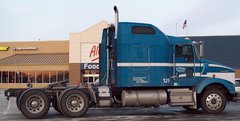MA road safety bills cover snow-free trucks, headlight use and road rage
While most legislatures around the country have closed for the year, a handful of statehouses, including Massachusetts, continue to meet.
Several bills of interest are drawing consideration in Massachusetts’ Joint Committee on Transportation. Among them are bills that would require snow and ice removal from trucks before taking to roadways, as well as use of headlights in bad weather. Another bill addresses road rage.
The Owner-Operator Independent Drivers Association is opposed to one bill that would get tough with truck drivers who fail to clear snow and ice off their vehicles. Sponsored by Rep. Cleon Turner, D-Dennis, the bill – H3350 – specifies that the wintry precipitation be removed when accumulation amounts to one quarter of an inch thick or more.
“It shall be the responsibility of the owner, as well as the operator of such vehicle to ensure the removal of accumulated snow and ice” before departure, Turner wrote.
Violators would face fines of at least $100. If injury or property damage occurs, fines would increase to $500.
A similar effort is on the governor’s desk in New Jersey. There, despite opposition from OOIDA and countless truck drivers who have long opposed what they say is legislation that sets truckers up to fail, lawmakers overwhelmingly endorsed the legislation.
The New Jersey bill would make drivers responsible for making “all reasonable efforts to remove accumulated ice or snow” from the hood, trunk and roof of the motor vehicle, truck cab, trailer or intermodal freight container.
Violators would face fines between $25 and $75. No points would be assessed against the driver’s license.
OOIDA says the snow and ice rule would be nearly impossible to comply with. They also cite concerns about requiring people to climb atop large vehicles to remove snow or ice.
Joe Rajkovacz, OOIDA’s regulatory affairs specialist, said the Massachusetts bill, like the measure in New Jersey, sets drivers up to fail.
“The road to hell is paved with good intentions. This is nothing more than a feel good measure that is a practical impossibility for truckers to comply with,” Rajkovacz told Land Line.
Rajkovacz said for efforts like these to be practical they must hold responsible more people than simply the truck’s driver or owner.
“These laws, if they are to even begin to make sense and be meaningful, have to hold accountable shippers and receivers for putting the infrastructure in place. Or the states themselves will have to have infrastructure in place for drivers to clear the rooftops,” he said.
Rajkovacz said these scenarios likely don’t cover unique loads, such as tarped machinery, when they accumulate snow or ice.
“How is a guy going to sweep the snow off that load? It’s impossible.”
While one Massachusetts bill addresses removal of snow and ice from trucks, another bill is intended to keep all vehicles back from snow and ice removal equipment. Sponsored by Rep. Harold Naughton Jr, D-Clinton, the bill – H3277 – would have all vehicles stay back 500 feet when the equipment is clearing snow and ice from roadways.
Six efforts intended to make roadways safer would require travelers to flip on their headlights when the windshield wipers are in use.
Naughton is the sponsor of another bill – H3279 – that addresses road rage. Law enforcement officers would be allowed to arrest drivers without warrants for actions that include following too closely, “purposely braking to endanger or annoy” the driver of a following vehicle, threatening another driver, making obscene gestures and unnecessary honking.
Violators would face the possibility of fines up to $1,000 and/or two and one-half years in prison. In addition to anger management classes, drivers would have their license revoked for between one year and five years. For commercial drivers, revocation would last between two years and five years.
To view other legislative activities of interest for Massachusetts in 2009, click here.
– By Keith Goble, state legislative editor
Editor’s Note: Please share your thoughts with us about the legislation included in this story. Comments may be sent to statelegislativedesk@ooida.com.


